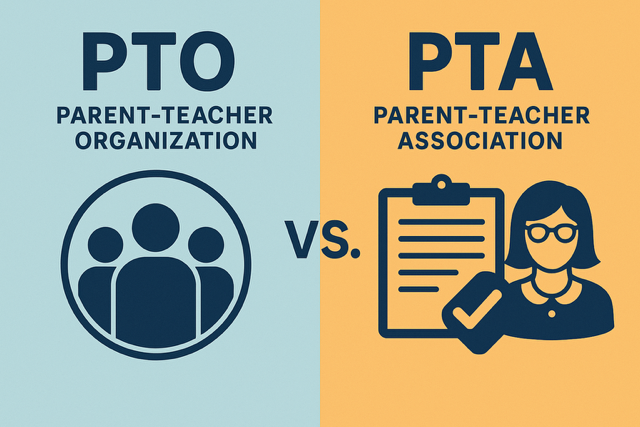
DISCOUNTED EDUCATION PRICING! CALL 1-877-891-8411. We Gladly Accept School Purchase Orders!

When it comes to parent involvement in schools, two acronyms frequently come up in conversations among educators, parents, and school administrators: PTO and PTA. These terms—Parent Teacher Organization (PTO) and Parent Teacher Association (PTA)—are often used interchangeably, but they actually represent two distinct types of parent-led school groups with different structures, governing rules, and levels of national affiliation.
While both PTOs and PTAs share the same overarching mission—to support students, teachers, and school communities through volunteering, fundraising, and engagement—they differ significantly in how they operate. From membership dues and organizational autonomy to access to national resources and legal structure, the differences between a PTO and a PTA can have a major impact on how effectively your school’s parent group functions.
Whether you’re a parent looking to get involved, a teacher searching for additional classroom support, or a school principal exploring ways to boost parent engagement, understanding the distinctions between PTO and PTA is essential. This complete PTO vs. PTA comparison guide will walk you through everything you need to know, including:
By the end of this guide, you’ll have a clear understanding of the best parent group option for your school—whether that’s joining the established network of the National PTA or launching a flexible, independent PTO tailored to your school’s unique needs.
If you’re trying to choose between a PTA or PTO for your school, this article will help you make an informed decision that aligns with your community values, leadership capacity, and goals for school-parent collaboration.
At first glance, they seem interchangeable—but their affiliations, governance, and flexibility are where the key differences lie.
The PTA (Parent Teacher Association) is a national nonprofit organization with chapters across the United States. Founded in 1897, the National PTA sets guidelines, provides resources, and advocates for legislation supporting children’s education and well-being.
When your school forms a PTA, it becomes a local unit under the umbrella of the National PTA and your state’s PTA. This comes with certain requirements, including:
A PTO (Parent Teacher Organization) is a school-specific, independent parent group that is not affiliated with any national organization. It can go by many names—PTC, HSA, HPTA—but it’s essentially a grassroots organizationformed by parents and staff to support their local school.
PTOs are self-governed, meaning the group creates its own bylaws, manages its own finances, and operates based on the school’s unique needs.
| Feature | PTA | PTO |
|---|---|---|
| Affiliation | National and state organization | Independent, local-only |
| Governance | Must follow national bylaws | Self-governed |
| Membership Dues | Paid to state and national PTA | No external dues |
| Resources | Access to national programs, advocacy, grants | Must develop own materials and strategy |
| Advocacy | National legislative efforts | Limited to local efforts |
| Name Recognition | Trusted national brand | Varies by school |
| Autonomy | Limited | Full control |
It depends on your school’s values, goals, and capacity.
There’s no one-size-fits-all answer—but understanding the difference can help you build a stronger, more effective parent-teacher partnership.
Whether your school community decides to form a PTO (Parent Teacher Organization) or a PTA (Parent Teacher Association), the ultimate goal remains the same: to support student success, empower teachers, and strengthen parent involvement in schools.
Both organizations play a vital role in building positive school culture, increasing volunteer participation, and organizing school fundraising events. They help create a bridge between home and school, giving families a voice and a way to contribute meaningfully to the learning environment.
Instead of focusing on which one is “better,” the more important question is:
“Which type of parent group aligns best with our school’s leadership, values, resources, and long-term goals?”
For some schools, a PTA’s structured support, national recognition, and advocacy network make it the perfect fit. For others, the flexibility, independence, and localized focus of a PTO offers the freedom needed to grow a community-driven parent organization that reflects their school’s unique needs.
Regardless of whether you choose a PTO or PTA, remember that the most successful school-parent partnerships are built on collaboration, clear communication, and shared purpose. The strength of a parent organization doesn’t come from its acronym—it comes from the passion, consistency, and connection among its members.
At the end of the day, it’s not about PTO vs. PTA.
It’s about parents and teachers working together to create a supportive, inclusive, and thriving school community where every child can succeed.